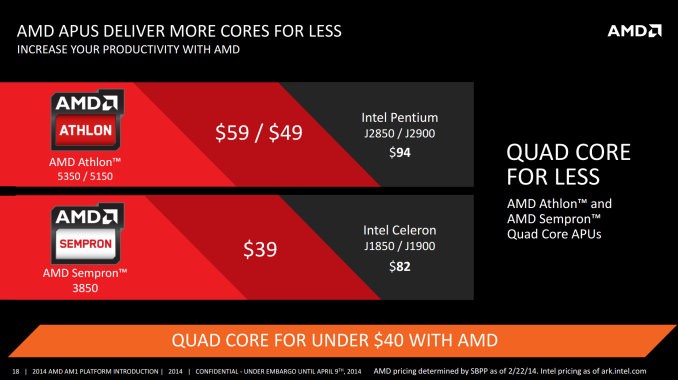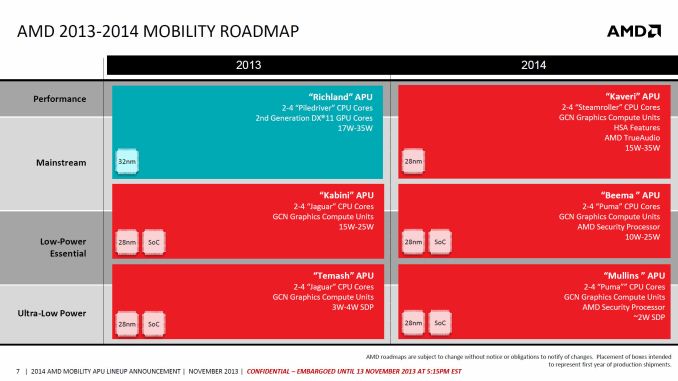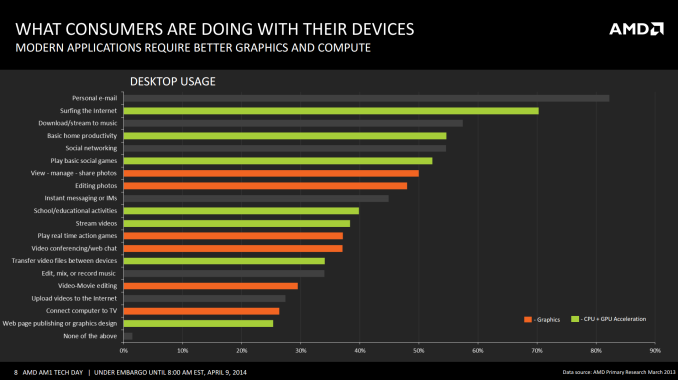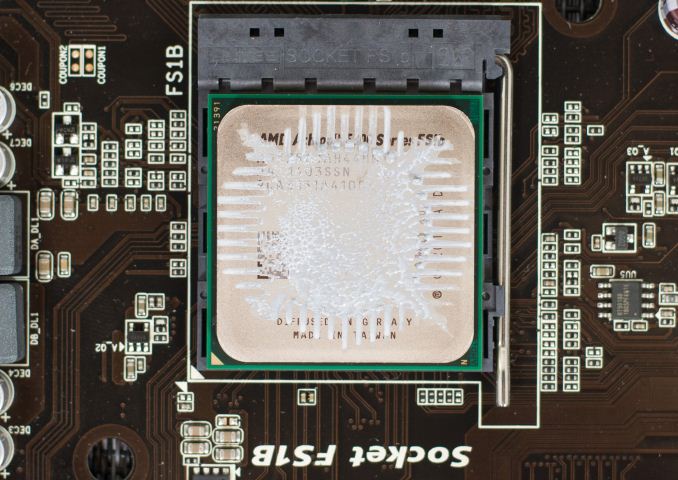The Desktop Kabini Review Part 1: AMD Athlon 5350 (AM1) Tested
by Ian Cutress on April 9, 2014 8:00 AM ESTFinal Words
As mentioned in our test setup, the benchmark results in this preliminary article are only a small fraction of our normal coverage. Due to other commitments we were unable to run every test on all comparison systems, but we have the other Athlon and Sempron APUs as well as comparable Intel counterparts coming in for review.
The poignant place to start with the final analysis is AMD’s claim of ‘Quad Core for Less’. In this statement alone, they are not wrong. Intel cannot provide a socketed quad core processor for less than $36 (Sempron 3850). The cheapest all-in-one desktop quad-core system from Intel equips the Celeron J1900 onto a motherboard for $92, which is exactly where AMD sit with the top-end Kabini based Athlon 5350 with a motherboard. One of the issues to consider at this point however is that Intel offers several dual core options (non-Atom) around this $40-$60 price point, and in many cases the IPC and CPU speed advantage of these cores is greater than that provided by Kabini, particularly in single threaded applications. The only downsides to this solution are the power consumption is higher, and the motherboards are more expensive. For a competitive socketed Intel dual core, a motherboard plus CPU can be in the region of $110-$120 at 35W-55W.
The big upside and selling point from the AM1 Kabini platform should be upgradeability. If a user buys an AM1 platform now, they should be able to upgrade it in the future. While AMD has not yet confirmed if Beema is coming to the socketed platform, the roadmaps suggest that the laptop sockets are remaining consistent from Kabini to Beema. This should imply that if Beema gets a socketed version, it should also remain based on AM1/FS1b.
If we compare single threaded performance between Kabini and our J1800 test system, the benchmarks are almost even between the two, particularly when it comes to synthetics such as Cinebench, but falls behind on emulation such as the Dolphin Benchmark and 3DPM. The integrated graphics of the Kabini pull ahead when it comes to gaming, despite the single channel memory interface.
|
AMD Athlon 5350 vs. Intel Celeron J1800 Single Threaded |
||
| Athlon 5350 | Celeron J1800 | |
| Cinebench R10 | 1967 | 1917 |
| Cinebench R11.5 | 0.51 | 0.49 |
| Dolphin Benchmark | 40.4 | 38.02 |
| 3DPM | 53.29 | 69.20 |
When placing Kabini against any Intel Ivy Bridge socketed processor, the increased IPC and frequency pushes the system above the Kabini, in exchange for more power and a more expensive system overall. If we compare the Kabini single-threaded results to those of the Celeron G465, a Sandy Bridge based single core CPU at 1.9 GHz, the Celeron does pull ahead on the majority, but fails miserably in the graphical benchmark suite.
|
AMD Athlon 5350 vs. Intel Celeron G465 Single Threaded |
||
| Athlon 5350 | Celeron G465 | |
| Cinebench R10 | 1967 | 2975 |
| Cinebench R11.5 | 0.51 | 0.73 |
| Dolphin Benchmark | 40.4 | 38.8 |
| 3DPM | 53.29 | 59.98 |
Does it seem particularly odd that a modern Kabini architecture at 2 GHz cannot keep up with a 3 year old Sandy Bridge processor at 1.9 GHz at our simple benchmarks? AMD is leveraging on the fact that much of what we do on a computer as a casual user can leverage the fixed function units of the graphics center of the APU:
AMD’s key in all of this is leveraging the GPU. For non-GPU intensive tasks, on paper, the J1900 for $92 and 10W TDP would seem to be the choice if upgradability is not a concern. The remit of AM1 and Kabini could be extended if motherboard manufacturers decided to use those extra PCIe lanes. Consider an AM1 with controllers to make a nice routing system (4x NIC) or something based around storage (SATA controllers and hubs). But because Kabini is also a cost play for AMD at the low-end desktop segment, margins are going to be ultra-tight for motherboard manufacturers and I do not imagine that as much effort will be put into making innovative products as the rest of their product range on other sockets.
In order for the upgradability angle to work, AMD need to keep the sockets around for at least two generations. AM1 comes late in Kabini’s life cycle, given that Beema on the mobile side is due out later in 2014. It would make sense for AMD to release Beema desktop parts, but the big question there is when. AMD could launch new processors on day 1 of Beema, or further into the life cycle. I would imagine that depends on what the competition does. AMD does have that advantage of having an upgradeable platform before Intel; however Intel may see the market differently. It is a hard one to judge.
Stay tuned for our full benchmark suite on the other AMD Kabini APUs.














126 Comments
View All Comments
Shivansps - Wednesday, April 9, 2014 - link
J1900 is quad, J1800 is dual.Anadtech did everything they could to make the 5350 look good, not incluiding Haswells is one giant red flag right there, the 5350 MUST be tested vs G1820 as well J1900 and AMD A4s, none of those tests where done to make the 5350 look good.
YuLeven - Wednesday, April 9, 2014 - link
But, but, but... but... G1820's power comsumption is a solid 25W more! Think of the dolphins and the trees! It must be rubbish!Communism - Wednesday, April 9, 2014 - link
The funny part is that the G1820's true TDP isn't anywhere near 55w.It's only listed as 55w TDP because Intel doesn't want to make selling their more expensive low power parts even harder :P.
Communism - Wednesday, April 9, 2014 - link
To put this in perspective, my 3570k supposedly has a TDP of 77w.It actually does about 70w for the CPU alone @ 4.4ghz running Intel Math Library Linpack (The highest heat output you're likely to ever see).
That was running just 5-10 degrees from TJmax as well, so superior cooling wasn't a large factor since the stock CPU w/ stock cooler @ stock speeds would be about that temperature as well.
jospoortvliet - Thursday, April 10, 2014 - link
Esp as it turns out that power usage compared to jaguar cores is barely a few percent lower and actually muc worse at idle. The final article will have to come back on this statement.riottime - Wednesday, April 9, 2014 - link
gosh. it's depressing looking at the stale fx line in that roadmap. :(FriendlyUser - Wednesday, April 9, 2014 - link
Great product! Ideal for an HTPC or NAS or even a casual desktop. It will be a hit in the weaker economies.Ranari - Wednesday, April 9, 2014 - link
It's a great product for the price, and that's all it needs to be: Quad core, a powerful and compute-capable GPU, and reasonably feature rich. The only thing that seems to be holding the Cat cores back are their clockspeeds.robbertbobbertson - Wednesday, April 9, 2014 - link
mini-PCIe slot cannot be used for cooking scrumptious bacon pancakesi am disappoint
QChronoD - Wednesday, April 9, 2014 - link
Just wanted to point out that the description of the IGP Gaming page says the tests are being done at 1080P and Xtreme settings, but it lists 1280x1024 on the graphs. Are they being done at the highest settings as well? I would imagine the test would be more useful if the settings were turned down to medium or low since that's what anyone with the system would actually be using.